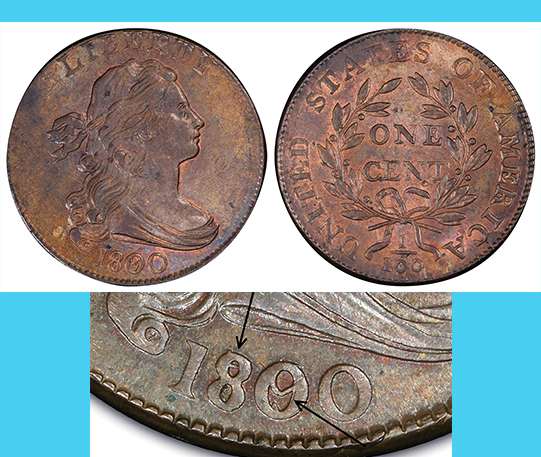
By Tom DeLorey
Within the general field of U.S. numismatics, there are the sub-fields of collecting error coins and coins with significant die varieties. I dealt with both groups when I was the editor of Coin World’s “Collectors Clearinghouse” department in the late 1970s, and as senior authenticator for the American Numismatic Association Certification Service in the early 1980s.
An error coin is often a mis-strike from normal dies on a normal planchet, but it can also reflect a problem with the dies and/or the planchet. It could be something like a coin struck off-center, or struck two or more times, or struck on a defective planchet or one intended for a different coin, among many other things. Typically, they are one-off occurrences, though sometimes they come in batches (such as the time a huge quantity of quarter dollar planchets were punched out of a coil of metal rolled to dime thickness), or involve multiple coins struck together in the press.
Die Variety Origins
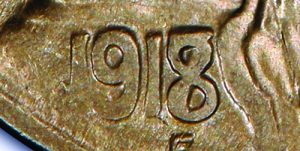
A die variety results when one or both of the steel dies either contains some sort of design element that is not supposed to be on the coin, contains a design element that is supposed to be there but is the wrong size or shape, or lacks a design element that is supposed to be there. Lots of coins contain very minor additions such as, say, a tiny raised lump of metal caused by a tiny chip out of the die that filled in with metal during the strike. These are generally not significant, but as the size of the break increases, so does the interest in it.
Lots of dies were cleaned or repolished during their lifetime, sometimes adding insignificant scratches to the dies or odd textures, but sometimes buffing away important details such as the foreleg on one 1937-D Buffalo nickel reverse die. In 1922, a Denver Mint obverse cent die was ground down to conceal impact damage to the die, so much so that the “D” mint mark was completely removed from the die. This became especially important when the Philadelphia Mint failed to strike any cents in 1922, making the 1922 “No D” cents extremely valuable.
Some 19th century coins have dates or mint marks stamped into their dies from punches intended for different denominations, which are larger or smaller than intended. Other more popular varieties have their dates or mint marks punched two or more times in approximately the correct position, while some of the wildest ones have one date in the right position and another (often incomplete) date punched high, like up in Liberty’s head or gown, or way down low in the denticles below the date.
Overdate Reign
However, the ‘King of Die Varieties’ remains the overdate, and its consort the over-mintmark. These altered dies occurred when the engraver prepared a die for use in one year but, for whatever reason, the coiner did not get around to using it in that calendar year. In the very early years of the U.S. Mint, this might have been the result of a shortage of the gold, silver or copper that die was intended to strike, or worse yet an epidemic of Yellow Fever that made Philadelphia too unhealthy for Mint workers to show up for work.
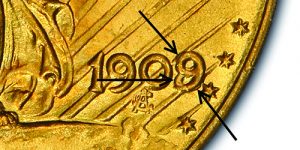
Sometimes the coiner would just quietly use up the now-obsolete die in the next calendar year, such as on 1796 quarters known to have been issued as 1797 strikes (which do not exist). However, some 1796 half dimes and half Eagles are known with their 6’s punched over previous year 5’s, so whether the engraver would bother to overdate an obsolete die or not may have depended upon how badly the coiner needed to use that die.
The technique for overdating dies has evolved significantly over the years. Assuming that the die had not yet been tempered to harden it, the Engraver might simply set the die on his workbench and use a steel number punch plus a mallet to punch the new last digit(s) over the old one(s). At the change of a decade, this could mean a two-digit overdate such as the 1810/09 cent, or a spectacular three-digit overdate such as the 1800/798 cent, one of my favorites.
The latter coin has a first cousin variety where the “1800” was punched over a partial date that only read “179.” Near the end of one calendar year, the Mint engravers would sometimes engrave dies with everything on them but the last digit of the date, so that they could finish and harden them with whatever digit was appropriate for the year the coiner received it. This die was probably started in 1798, not used in 1799, and finished with an 1800 date.
Overdating Specifics
As the new digit punch physically entered the die steel, it would displace some of that steel sideways into the hole(s) which formed the earlier date. It would also displace some die steel upwards around the impression, like the crater rim formed by a meteor strike on the moon. That cratering effect was not uncommon wherever dates or mint marks were hand punched into normal dies, but the engraver routinely polished it away in the finishing process for a new die.
When overdating a die, a skilled engraver with the time to do so might tap-tap some of that raised die steel around to likewise fill in some of that earlier date. It must be presumed that in some cases he succeeded in completely obliterating the underdate. We collect the instances where he did not.
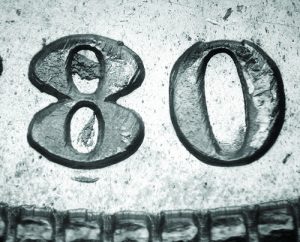
At some point in the 19th century, the Engraving Department began experimenting with filling in the hole(s) that made up the older date, smoothing down the surface, and then hand-punching the new digit(s) into the restored field. According to numismatic researcher and author Roger W. Burdette, in his book From Mine to Mint:
“Fill original digit with steel or iron wire, or filings/metal dust. Compress with original digit punch. Smooth surface to match field with abrasive. Punch new digit and again smooth.
Result. Overdating can range from invisible to obvious depending on the mechanical strength of filling. Portions of filling might be excellent, and others might not hold up well.”
Overdate Examples
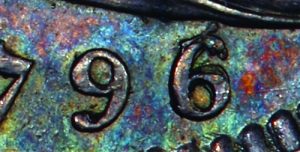
The 1827/6 half dollar obverse (paired with different reverse dies to make Overton varieties 101, 102 and 103) shows a strong remnant of the bottom part of the 6 on either side of the bottom of the 7 in its earliest die state, yet on the later die states this part of the 6 has been eroded or polished away while strong remnants of the middle and top of the 6 have magically appeared. This could have occurred if some filling in the original 6 deteriorated over time, but it is also possible that the metal moved around by the overpunching was weakened and it eroded faster than the rest of the die steel. This is but one example of why collecting overdates can be so much fun.
Overdates sometimes come in batches. Typically, this was because of some sort of interruption in the supply of new dies, forcing the overdating of older ones. The War of 1812 interrupted the supply of die-quality steel from England, possibly giving us the 1814/3 Half Eagle, the 1815/2 half dollar, and an odd pair of 1817 half dollars with the 7 punched over either a 3 or a 4. The decline and ultimate death of Chief Engraver Robert Scot in late 1823 gave us numerous oddly-dated coins in this era, including an 1824 half dollar where the 4 is believed to have been punched over a 2 that had previously been punched over a zero.
The hiring of Chief Engraver James B. Longacre in 1844 gave us a new kind of “overdate,” a cent die on which 1844 was first punched upside and then repunched correctly. The same error occurred on a cent die of 1851, a half dime die of 1858, and a gold Eagle die of 1865.
Though the purists in the variety hobby insist, correctly, that these are blundered dies instead of true overdates, the wild tangles of digits make them very popular among collectors of die varieties.
Simple economy was a good reason for overdating dies in batches. For example, in 1846 the coinage of half dimes was extremely low, and several 1846 obverse dies (some reports say five, though it is not known if they were originally assigned to the Philadelphia Mint or New Orleans or both) were returned to the Engraving Department as unused. There they sat until 1849 when at least three of them were punched with a four-digit 1849 punch and put into use.
Overdate Appeal Legendary
When 20th-century collector Daniel Webster Valentine discovered the 1849 overdates in the 1920s or earlier, he misattributed them all as 1849/8 varieties in his monograph published in 1931, presumably because the logical source for an underdate is the previous year’s dies. Since then, various collectors have called this die a 1849/6 and that die a 1849/8, with other collectors calling the first die a 1849/8 and the second die a 1849/6. I have been working on the question for about 40 years and have recently convinced almost everybody that they are all 1849/6 dies. It has been an interesting challenge.
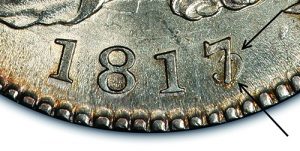
The only backward overdate on a U.S. coin occurred in either late 1853 or early 1854 when a quarter dollar obverse die already dated 1854 was punched with an 1853 date and then used. I have a theory as to why this happened.
In early 1853 the price of silver was high relative to gold, and so the Mint reduced the weights of the silver half dime, dime, quarter dollar, and a half dollar by about 7% to discourage hoarding and melting. To make it easier for Treasury and Mint representatives to withdraw the older, heavier coins for melting by the Mint, arrows were placed on either side of the date on all four denominations of the new coins, and a “glory” or sunburst of rays around the Eagle on the quarter and the half.
The reverse with the rays did not strike up well, and so it was decided to eliminate the rays in 1854. If at the very end of 1853 or the very start of 1854 an unused With Rays quarter dollar reverse die was found, and there were no more 1853 obverses left to use with it, an 1854 die might have been backdated to 1853 to keep from creating a rare “mule” design.
Leftovers Prompt Overdate Deluge
The greatest grouping of U.S. overdates occurred in 1880 when a huge number of leftover 1879 Morgan Dollar obverse dies were re-dated as 1880 and distributed to all four Mints. I do not know why there were so many leftover 1879 dies, but Chief Engraver Charles Barber succeeded his father William in the position in 1879, and the son’s inexperience may have caused him to misread the Coining Department’s demand for dies.
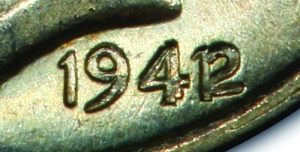
The 1880/79-P, CC, O and S dollars can show traces of the 7 and/or the 9 either inside or outside the 8 and/or the 0. Some varieties such as the 1880/79-P VAM-23 (which I discovered in 1975) show bold portions of the underdate atop the raised replacement digits on the finished coin, showing that the overdate was not punched as deeply into the die steel as the original date. If the 9 was filled in on that die, the filling popped out like a child’s tooth filling when he bites into a piece of hard caramel.
VAM refers to Leroy Van Allen and George Mallis, two silver-dollar die variety pioneers who joined forces to write the definitive work on silver dollar varieties. I am proud to have a few discoveries of my own in their work.
Some of the Carson City overdates from 1880 are wonderfully clear and joys to behold if you are a collector of die varieties. It is thought by some that the Engraving Department tended to send its worst quality dies (from their point of view) to the remotest branch Mints, from whence the coins that they struck were less likely to be seen by the nobs at Mint headquarters. This may be true in general, but it would not explain the 1880-P 8/7 VAM-6, used in Philadelphia with almost the entire top of the 7 showing.
Overdates Prompt Collecting Wisdom
It is my favorite among the 1880/79 overdates, which hold a special place in my heart because they literally changed my life. In 1970 I was an accounting major at Wayne State University in Detroit, willing to pursue a sedentary (if boring) desk job that would go easy on my polio-damaged leg. I hated it. Then collector and researcher Ted Clark published a multi-part series of articles on the 1880/79 overdate dollars in the pages of Coin World’s Collectors Clearinghouse, and I was hooked.
I saved the articles and went looking for the overdates at coin shows, and in one year “cherrypicked” enough overdates to pay that year’s tuition. When I mislaid the articles I found an excuse to visit the Clearinghouse office in Sidney, Ohio to get another set, and when I looked out their third-floor window at the town’s Norman Rockwell classic Courthouse Square I decided right then and there that I was going to work there someday. By the fall of 1976, I was the editor of the Clearinghouse department.
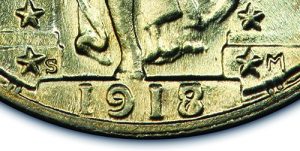
The last punched overdate appeared on the 1901/0-S gold half Eagle, which is technically a dual-century overdate if you accept the mathematical fact that centuries end with years ending in two zeroes. Starting in 1907, the Mint began phasing in hubs with their dates already on them, thereby eliminating the need to hand punch a die or overdate one. By the end of 1908, all hubs were dated.
Of course, in late 1908, as the Engraving Department was starting work on the 1909 dies, somebody took a gold $20 obverse die that had been started with the 1908-dated hub and finished it with the 1909 hub, leaving a nice, crisp 9/8 overdate. The coins from this die are not rare and are easily affordable if the value of the gold in the coin does not scare you away.
Similar hubbing-caused overdates occurred in 1918 on a 1918/7-D nickel and a 1918/7-S quarter, in 1942 on one each 1942/41-P&D dimes, and in 1943 on a 1943/42-P nickel. It has been speculated that World Wars I and II may have contributed to these last five overdates, either because the skilled hubbing operators were off to war or simply to conserve die steel under wartime conditions. We may never know the truth.

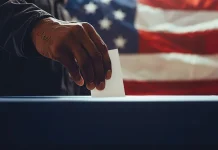
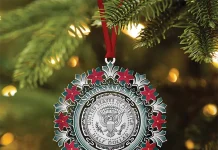
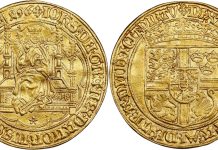











Please send me all info
Coinage this is a great info to know for a collect to have.